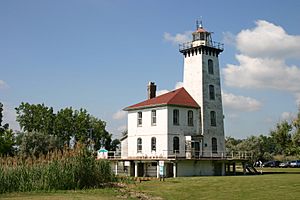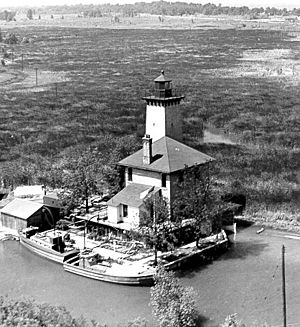Saginaw River Rear Range Light facts for kids
 |
|
| Saginaw River Rear Range Light | |
|
|
|
| Location | Bangor Township, Bay County, Michigan |
|---|---|
| Coordinates | 43°38′7.8″N 83°51′2″W / 43.635500°N 83.85056°W |
| Year first constructed | 1839 to 1841 |
| Year first lit | 1876 |
| Deactivated | 1960 |
| Foundation | Timber piles/concrete/steel sheeting |
| Construction | Cream City Brick covered with concrete |
| Tower shape | Square tapered |
| Markings / pattern | white/black trim |
| Height | 59 feet (18 m) |
| Focal height | 77 feet (23 m) |
| Original lens | 4th order Fresnel lens |
| Range | 8.5 nautical miles (15.7 km; 9.8 mi) |
| ARLHS number | USA-717 |
The Saginaw River Lighthouse is a historic building in Michigan. It helped guide ships carrying lots of lumber from Michigan to the East Coast. This was very important for the area's growth.
The first lighthouse was built between 1839 and 1841. Later, in 1867, the United States Army Corps of Engineers made the Saginaw River deeper. This allowed bigger ships to travel upriver. Because of this change, the first lighthouse was no longer in the best spot.
So, in 1876, two new lighthouses were built. They worked together as a "range light" system to guide ships better. The front light was on the riverbank, and the rear light, which also had living quarters, was further south. In 1915, both lighthouses started using electricity.
The rear range lighthouse closed in the 1970s. It was added to the National Register of Historic Places in 1984. The Dow Chemical Company bought the lighthouse and its land in 1986. Since the early 2000s, the Saginaw River Marine Historical Society has been working to fix up the lighthouse. They want to open it for visitors to learn about its history.
Contents
Early Days of the Lighthouse
European-American settlers started living along the Saginaw River in the 1830s. The river was very important because ships could travel far inland. Building the Saginaw Bay Lighthouse was key to marking the river's entrance.
Work on the first lighthouse began in July 1839. It was finished in the fall of 1841. By this time, the lumber industry was growing fast. Much timber was sent down the river, through the Great Lakes, and then through New York's Erie Canal to markets in the eastern United States.
Why a New Lighthouse Was Needed
In 1867, the United States Army Corps of Engineers made the Saginaw River channel deeper. This allowed larger ships to use the river. After this work, the first lighthouse was not in the right place to guide boats safely.
It took some time to get money and land for a new light. Finally, in 1876, two new lighthouses were built. They were set up as a "range light" system.
How Range Lights Work
Range lights are a pair of lights that help ships stay on the right path. The taller "rear" light is placed behind the "front" light. When a ship's captain sees the two lights lined up one above the other, they know they are on the correct path.
- If the front light appears to the left of the rear light, the ship is too far to the right of the path.
- If the front light appears to the right of the rear light, the ship is too far to the left of the path.
This system helps sailors navigate safely, especially in narrow channels.
The Front Range Light
The "front" range light was built on a square timber platform next to the west river bank. It was a 34-foot-tall white wooden pyramid. It had a small room at the bottom for storing oil and supplies. This room also gave the keeper shelter in bad weather. The light had a small, fixed white lens that could be seen about 8.5 miles out into the bay.
The Rear Range Light Building
The "rear" range light was built about 2,300 feet south of the river's mouth. It was designed by Major Godfrey Weitzel. This building was special because it combined the lighthouse tower with the Lighthouse keeper's home.
Because the ground was swampy, strong timber piles were driven deep into the earth. These piles created a solid base for the concrete foundation. On top of this, a square, two-story brick house was built. It was made of Cream City brick.
A 53-foot-tall square tower was part of the house. Inside the tower, spiral stairs made of cast iron went from the basement all the way to the top. These stairs were also the only way to get to the first and second floors of the house. The living area had a kitchen, a living room, and an oil storage room on the first floor. There were three bedrooms upstairs.
The tower had an octagonal (eight-sided) cast iron lantern at its top. Inside was a fixed white lens. This light was 61 feet high and helped guide ships.
Later Years and Restoration
In 1915, both range lights were changed to use electricity. The rear range light stayed active and was used as a home for US Coast Guard staff until the 1970s. Then, the Coast Guard Station moved across the river for more space. The lighthouse was empty until 1986. The Dow Chemical Company, which owned the land around it, bought the lighthouse and boarded it up.
In 1999, the Saginaw River Marine Historical Society (SRMHS) talked to Dow about working together to restore the lighthouse. They wanted to open it for tourists. The SRMHS is now renovating the lighthouse. Other groups, like Lighthouse Friends, are helping to raise money. In 2002, the SRMHS even got a historic lens like the one used in the lighthouse between 1930 and 1960.
It is thought that the Saginaw River lighthouse was one of the first places to use range lights. The river is still very busy today, carrying almost 5 million tons of goods each year. This lighthouse is an important part of history and is listed on the National Register of Historic Places.
Images for kids





